Top speed 1,118 km/h Length 13 m Weight 5,200 kg | Range 1,304 km Wingspan 10 m Unit cost 769,330–769,330 USD | |
 | ||
Republic f 84f thunderstreaks go to the netherlands 1955
The Republic F-84F Thunderstreak was an American-built swept-wing turbojet fighter-bomber. While an evolutionary development of the straight-wing F-84 Thunderjet, the F-84F was a new design. The RF-84F Thunderflash was a photo reconnaissance version.
Contents
- Republic f 84f thunderstreaks go to the netherlands 1955
- Development
- Thunderflash
- Design
- Operational history
- Variants
- Operators
- Belgium
- Italy
- Norway
- Poland
- Russia
- Turkey
- United Kingdom
- United States
- Accidents and incidents
- Specifications F 84F
- Notable appearances in media
- References
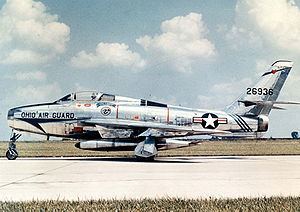
Development
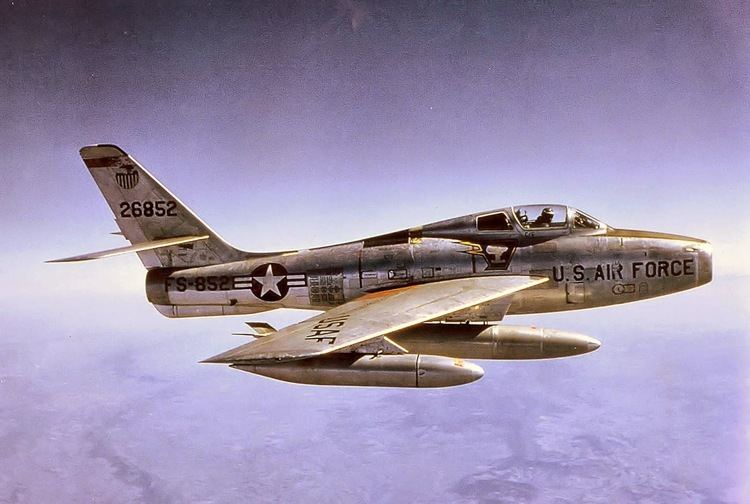
In 1949, a swept wing version of the F-84 was created with the hope of bringing performance to the level of the F-86. The last production F-84E was fitted with a swept tail, a new wing with 38.5 degrees of leading edge sweep and 3.5 degrees of anhedral, and a J35-A-25 engine producing 5,300 pound-force (23.58 kN) of thrust. The aircraft was designated XF-96A. It flew on 3 June 1950 with Otto P. Haas at the controls. Although the airplane was capable of 602 knots (693 mph, 1,115 km/h), the performance gain over the F-84E was considered minor. Nonetheless, it was ordered into production in July 1950 as the F-84F Thunderstreak. The F-84 designation was retained because the fighter was expected to be a low-cost improvement of the straight-wing Thunderjet with over 55 percent commonality in tooling.
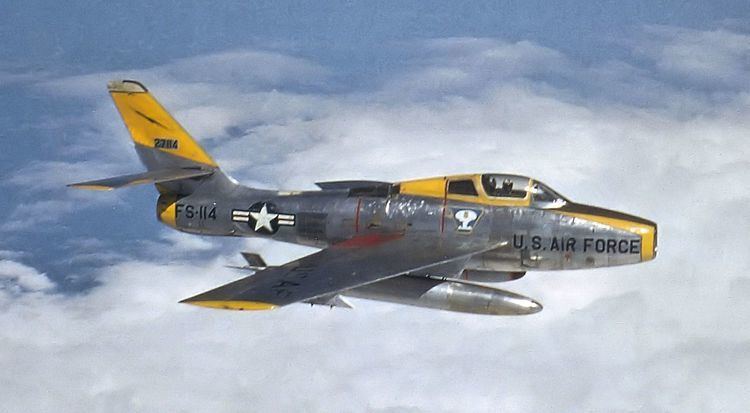
In the meantime, the USAF, hoping for improved high-altitude performance from a more powerful engine, arranged for the British Armstrong Siddeley Sapphire turbojet engine to be built in the United States as the Wright J65. To accommodate the larger engine, YF-84Fs with a British-built Sapphire as well as production F-84Fs with the J65 had a vertically stretched fuselage, with the air intake attaining an oval cross-section. Production delays with the F-84F forced the USAF to order a number of straight-wing F-84Gs as an interim measure.
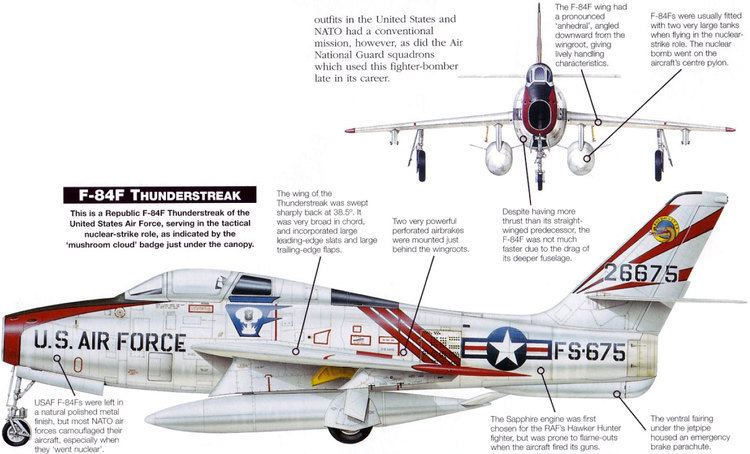
Production quickly ran into problems. Although tooling commonality with the Thunderjet was supposed to be 55 percent, in reality only fifteen percent of tools could be reused. To make matters worse, the F-84F utilized press-forged wing spars and ribs. At the time, only three presses in the United States could manufacture these, and priority was given to the Boeing B-47 Stratojet bomber over the F-84. The YJ65-W-1 engine was considered obsolete and the improved J65-W-3 did not become available until 1954. When the first production F-84F finally flew on 22 November 1952, it differed from the service test aircraft. It had a different canopy which opened up and back instead of sliding to the rear, as well as airbrakes on the sides of the fuselage instead of the bottom of the aircraft. The aircraft was considered not ready for operational deployment due to control and stability problems. The first 275 aircraft, equipped with conventional stabilizer-elevator tailplanes, suffered from accelerated stall pitch-up and poor turning ability at combat speeds. Beginning with Block 25, the problem was ameliorated by the introduction of a hydraulically powered one-piece stabilator. A number of aircraft were also retrofitted with spoilers for improved high-speed control. As a result, the F-84F was not declared operational until 12 May 1954.
Thunderflash

The second YF-84F prototype was completed with wing-root air intakes. These were not adopted for the fighter due to loss of thrust. However, this arrangement permitted placement of cameras in the nose and the design was adopted for the RF-84F Thunderflash reconnaissance version. The first YRF-84F was completed in February 1952. The aircraft retained an armament of four machine guns and could carry up to fifteen cameras. Innovations included computerized controls which adjusted camera settings for light, speed, and altitude, a periscope to give the pilot better visualization of the target, and a voice recorder to let the pilot narrate his observations. Being largely identical to the F-84F, the Thunderflash suffered from the same production delays and engine problems, delaying operational service until March 1954. The aircraft was retired from active duty in 1957, only to be reactivated in 1961, and finally retired from the ANG in 1972.
Several modified Thunderflashes were used in the FICON project.
Design
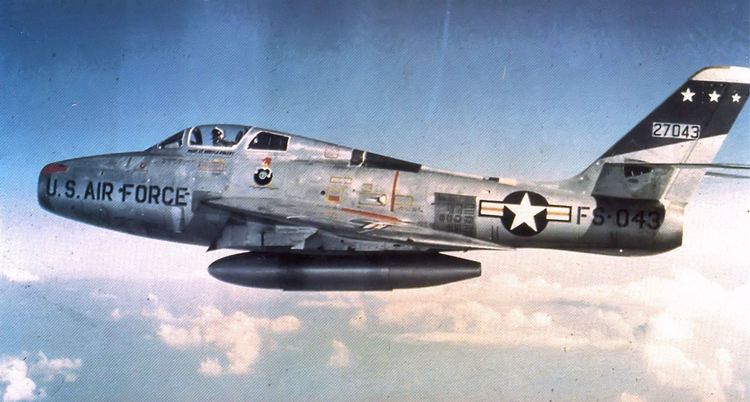
The Thunderstreak suffered from the same poor takeoff performance as the straight-wing Thunderjet despite having a more powerful engine. In reality, almost 700 pounds-force (3.11 kN) or ten percent of total thrust was lost because the J65 was installed at an angle and its exhaust had a prominent kink. On a hot day, 7,500 feet (2,285 m) of runway were required for takeoff roll. A typical takeoff speed was 160 knots (185 mph, 300 km/h). Like the Thunderjet, the Thunderstreak excelled at cruise and had predictable handling characteristics within its performance envelope. Like its predecessor, it also suffered from accelerated stall pitch-up and potential resulting separation of wings from the airplane. In addition, spins in the F-84F were practically unrecoverable and ejection was the only recourse below 10,000 feet (3,000 m).
Operational history
Project Run In completed operational tests in November 1954 and found the aircraft to be to USAF satisfaction and considerably better than the F-84G. However, ongoing engine failures resulted in the entire fleet being grounded in early 1955. Also, the J65 engine continued to suffer from flameouts when flying through heavy rain or snow. As the result of the problems, the active duty phaseout began almost as soon as the F-84F entered service in 1954, and was completed by 1958. Increased tensions in Germany associated with construction of the Berlin Wall in 1961 resulted in reactivation of the F-84F fleet. In 1962, the fleet was grounded due to the corrosion of control rods. A total of 1,800 man hours were expended to bring each aircraft to full operational capacity. Stress corrosion eventually forced the retirement of ANG F-84Fs in 1971.
On 9 March 1955, Lt. Col. Robert R. Scott, in a F-84F Thunderstreak, set a three-hour, 44-minute and 53-second record for the 2,446 mile flight from Los Angeles to New York.
With the appearance of the Republic F-105 Thunderchief, which also used wing-root mounted air intakes, the Thunderstreak became known as the Thud's Mother. The earlier F-84A had been nicknamed the "Hog" and the F-84F "Super Hog," the F-105 becoming the "Ultra Hog".
In what is probably one of the very few air-to-air engagements involving the F-84F, two Turkish Air Force F-84F Thunderstreaks shot down two Iraqi Il-28 Beagle bombers that crossed the Turkish border by mistake during a bombing operation against Iraqi Kurdish insurgents. This engagement took place on 16 August 1962.
The F-84F was retired from active service in 1964, and replaced by the North American F-100 Super Sabre. The RF-84F was replaced by the RF-101 Voodoo in USAF units, and relegated to duty in the Air National Guard. The last F-84F Thunderflash retired from the ANG in 1971. Three Hellenic Air Force RF-84Fs that were retired in 1991 were the last operational F-84s.
Variants
Operators
Belgium
Italy
Norway
Poland
Russia
Turkey
United Kingdom
United States
Accidents and incidents
Specifications (F-84F)
Data from Fighters of the United States Air Force, Combat Aircraft since 1945
General characteristics
Performance
Armament
Avionics
Communications Equipment
Notable appearances in media
Richard Bach, who later wrote the bestseller Jonathan Livingston Seagull, was an ANG F-84F pilot who was once activated for duty in Europe. His first book, Stranger to the Ground, described in detail what it was like to fly the Thunderstreak in the course of an operational flight at night from England to France in adverse weather.
F-84Fs were also used to represent North Korean MIG-15 fighters in the 1958 film version of James Salters' novel "The Hunters", because none of the Soviet fighters were available during the ongoing Cold War for filming. They were painted a flat gray with red star insignia.
